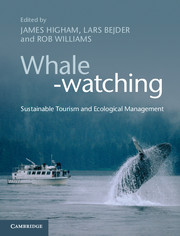Book contents
- Frontmatter
- Dedication
- Contents
- Acknowledgements
- List of contributors
- List of abbreviations
- 1 Tourism, cetaceans and sustainable development
- Part I The historical and contemporary contexts
- Part II Human dimensions of whale-watching
- 7 The whaling versus whale-watching debate
- 8 Iceland and the resumption of whaling
- 9 Green messengers or nature's spectacle
- 10 Whale-watching
- 11 What's in it for the whales?
- 12 Integrating traditional ecological knowledge and community engagement in marine mammal protected areas
- Part III Ecological dimensions of whale-watching
- Part IV Sustainable management: insights and issues
- Index
- Plate Section
- References
12 - Integrating traditional ecological knowledge and community engagement in marine mammal protected areas
from Part II - Human dimensions of whale-watching
Published online by Cambridge University Press: 05 April 2014
- Frontmatter
- Dedication
- Contents
- Acknowledgements
- List of contributors
- List of abbreviations
- 1 Tourism, cetaceans and sustainable development
- Part I The historical and contemporary contexts
- Part II Human dimensions of whale-watching
- 7 The whaling versus whale-watching debate
- 8 Iceland and the resumption of whaling
- 9 Green messengers or nature's spectacle
- 10 Whale-watching
- 11 What's in it for the whales?
- 12 Integrating traditional ecological knowledge and community engagement in marine mammal protected areas
- Part III Ecological dimensions of whale-watching
- Part IV Sustainable management: insights and issues
- Index
- Plate Section
- References
Summary
Introduction
Increasing impact on the world's oceans from development, pollution, overharvesting of resources and other human-related causes stems from our failure to recognize that our oceans are not an indestructible and infinite resource. Today, signs of stress and the diminishing health of our oceans are commonplace and globally we have begun to acknowledge that our oceans are in crisis (Pauly et al., 1998; Mora et al., 2009). Marine life and vital coastal habitats are under increasing pressure from overuse, and the cumulative effects of human activities in the ocean reduces its ability to function as a healthy ecosystem (Halpern et al., 2008). The costs of pollution, overfishing, and destruction of habitats threaten local food security, livelihoods, and the health and welfare of human communities reliant on the ocean (Kent, 1997; Bell et al., 2009; Halpern et al., 2012). Current approaches to management, planning and policy have thus far relied too heavily on fragmented and piecemeal governance, rather than systematic, ecosystem-based approaches that are needed to preserve ocean ecosystem health and the resilience of human communities (Crowder et al., 2006; Spalding et al., 2008; Pressey & Bottrill, 2009).
Impacts and depletion of marine mammals is a subset of the global crisis facing our ocean. Persistent and major threats to marine mammals include historical exploitation, habitat loss and by-catch, pollution, ocean noise, and overharvesting (Erbe, 2002; Schipper et al., 2008; Simmonds & Isaac, 2007; McClenachan & Cooper, 2008). Reducing these threats requires a systematic approach to management of marine mammals, with multi-dimensional responses that are both species- and location-specific (Taylor et al., 2000; Marsh et al., 2003).
- Type
- Chapter
- Information
- Whale-watchingSustainable Tourism and Ecological Management, pp. 163 - 174Publisher: Cambridge University PressPrint publication year: 2014
References
- 1
- Cited by



